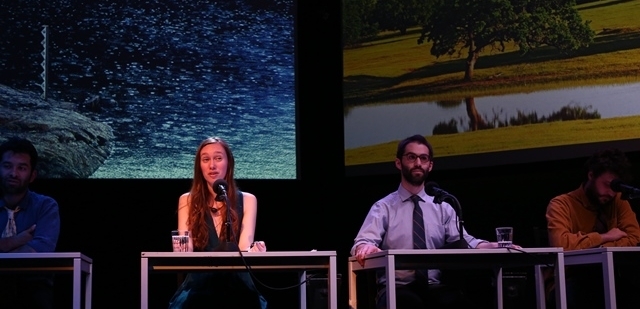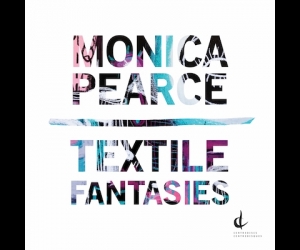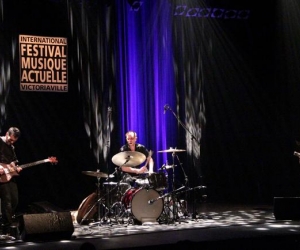
It would have been easy to walk into the Whitney Museum, head for the ticket counter and on to the elevators, while entirely missing the first of the pieces by more than one hundred artists in the 2014 Biennial. The sounds drifting down from the ceiling in the American composer-and-instrument-builder Sergei Tcherepnin's Ambient Marcel (Walking, Working Erupting), were arbitrary tones from electronic wind chimes, barely audible even when the crowds were small. The soundtrack served as a perfect (if unintentional) analogue to the museum-going experience: even before making it to the galleries, the compulsion was to move through the overwhelming assembly of art and people and get to the next thing.
The next thing encountered—if you walked up the stairs—was far more difficult to miss. Belgium-based American composer Charlemagne Palestine filled the main stairwell with drones that seemed out of place, while being very much of the place. He made the source recordings for his site-specific installation hauntteddd!! nhuntteddd!! n daunttlesss!! n shuntteddd!! while walking up and down that same stairwell, chanting. A series of speakers decorated with his beloved stuffed animals was synchronized so the voice travelled up and down the stairs at the rate at which he climbed them.
Following Palestine’s disembodied voice up to the second floor led the visitor to a small studio which housed one of the highlights of the biennial: a series of stagings of works by Robert Ashley, the composer who brought opera into contemporary times while declaring he hated the word, and who died in March at the age of 83. The works, directed by cellist and composer Alex Waterman, were in preproduction at the time of Ashley’s passing, and became a tribute to the composer, who had made New York his home for close to forty years. Along with a Spanish-language presentation of what is perhaps his most celebrated work, the seven-part serial Perfect Lives (or, in this staging, Vidas Perfectas), the biennial included the premiere of a new work, Crash, which Ashley was rehearsing at the time of his death, and later in the festival, the 1968 work The Trial Of Anne Opie Wehrer And Unknown Accomplices For Crimes Against Humanity. All received multiple stagings in the Kaufman Astoria Studios Film and Video Gallery, which allowed for a small audience of about thirty, as well as a multicamera shoot of Vidas Perfectas.
Crash, for singers without musical accompaniment, was described by Ashley in the program notes as a “meditation” and indeed made for strangely passive listening. Two trios alternated narration and accompaniment, the narrators also taking turns as the accompanying voices repeated phrases such as “speak too softly, speak too fast” and “there’s supposed to be another” in metered whispers often too soft to be made out. The stories of rural childhood, of schoolyard bullies and bully nations, and of the gaining of artistic success certainly seemed autobiographical, considering Ashley’s Michigan childhood and early career in film. A series of anecdotes and reflections, generally incidental and sometimes amusing, gained momentum, as a character and then a storyline gradually developed. But matter-of-fact delivery and repetitive accompaniment made it easy (as is so often the case with Ashley’s work) to let the content float past. The experience was very much like watching television, a form he often modelled his work on. The stories were more clever, of course, the comedy richer, the irony more subtle, the sentiment less ham-fisted; it was a composition held together by the scored tonal qualities of the voices, which almost sabotaged the presentation of a narrative. With the performers only feet away, still photos of trees, boats, landscapes, and clouds, projected on three screens behind the performers, lulled the mind.
Commissioned by The Kitchen in 1979 and consisting of seven half-hour episodes, Perfect Lives adheres more closely to the TV trope. The story involves a bank robbery and a couple on the lam, but being presented in Spanish (Waterman developed the new version working closely with Ashley), it became, to the non-Spanish speaker, mesmerizingly abstract. Occasional words (e.g., “half pint”) or a familiar Hank Williams melody (although not sung in English) slipped through and gave moments of context.
The Whitney Biennial continued through the end of May with the third Ashley staging, as well as sound installations by Kevin Beasley and Pauline Oliveros. If sound art was a secondary focus in the highly influential Whitney event, the quality of the programming was nevertheless excellent.
Image: (left to right) Paul Pinto, Gelsey Bell, Dave Ruder, and Brian McCorkle in the premiere performance run of Robert Ashley's Crash, presented at the Whitney Biennial 2014, in the New York City, in May 2014. Image by: Paula Court, courtesy of The Whitney Museum of American Art.


